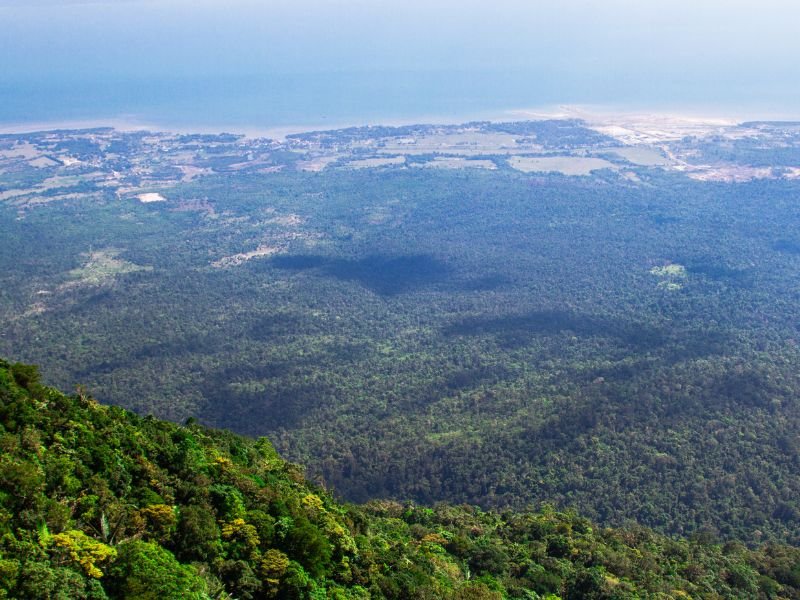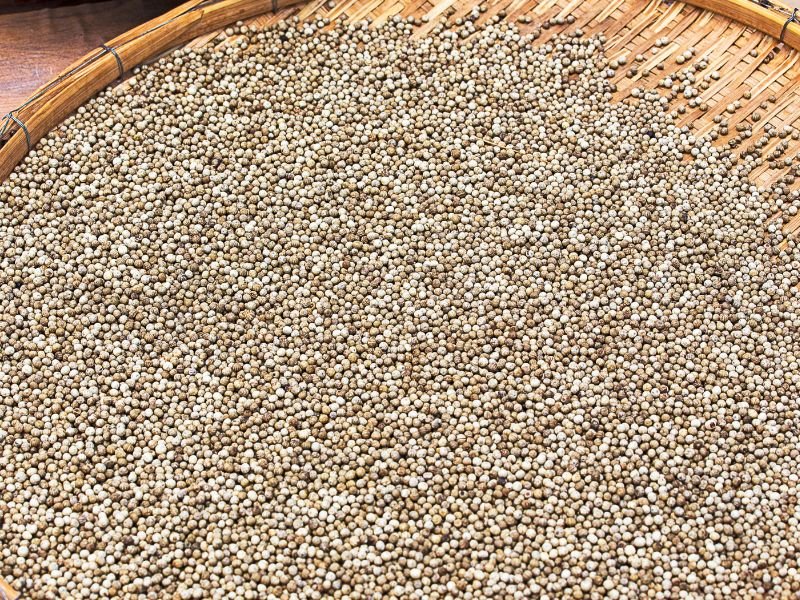Nestled along the banks of the tranquil Praek Tuek Chhu River, Kampot is a charming riverside town that beckons travelers with its laid-back vibe. Known for its lush landscapes, colonial architecture, and world-famous pepper, Kampot has plenty on tap. The town’s quiet streets are dotted with quirky cafés, cozy guesthouses, and boutique shops, making it an ideal destination for those seeking a slower pace. Whether you’re kayaking on the river, exploring nearby caves, or savoring the local cuisine, Kampot is a place that invites you to unwind and enjoy the simple pleasures of life. It’s the perfect spot to escape the hustle and bustle and immerse yourself in Cambodia’s natural beauty.
source: Paddy Doyle on YouTube
- Stunning Scenery: Enjoy panoramic views of the river, mountains, and lush greenery that surround this serene town.
- Colonial Charm: Wander through streets lined with beautifully preserved French colonial buildings, each telling a story of Kampot’s past.
- World-Renowned Pepper: Don’t miss a visit to a local pepper farm to learn about Kampot’s famous spice and sample its unique flavors.
Tip: Rent a bicycle or scooter to explore Kampot’s countryside at your own pace—it’s the best way to discover hidden gems and local attractions.
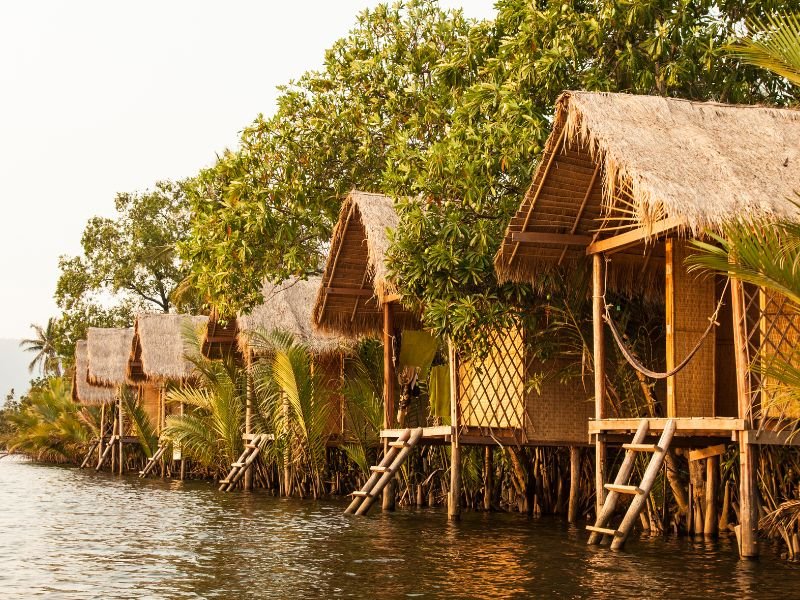
Relax by the Riverside
One of Kampot’s greatest draws is its tranquil riverside setting. Here life moves at a slower pace. The riverfront is lined with charming guesthouses, restaurants, and bars, offering the perfect spot to enjoy a cool drink and watch the sunset over the water. Rent a kayak or paddleboard to explore the calm waters, or simply sit back and enjoy the view from a riverside café. As the sun dips below the horizon, the riverside comes alive with soft lights and a laid-back, friendly atmosphere. It’s the ideal place to unwind and soak in the beauty of this peaceful town.
- Kayaking and Paddleboarding: Rent a kayak or paddleboard to explore the river’s serene waters and hidden coves.
- Sunset Views: Enjoy spectacular sunsets from one of the many riverside cafés or bars.
- Relaxed Atmosphere: Unwind with a drink in hand, surrounded by the peaceful sounds of the river and nature.
Tip: Head to the riverfront in the late afternoon for the best sunset views and to grab a good spot at one of the popular cafés.
Discover the Secret of Kampot Pepper
Kampot’s pepper is famous around the world, and a visit to one of the area’s many pepper farms is a must. Take a guided tour to learn about the meticulous process of growing, harvesting, and drying this prized spice. You’ll discover the different varieties of Kampot pepper, each with its own unique flavor profile, from the zesty green peppercorns to the rich and spicy red and black varieties. After the tour, enjoy a pepper tasting session and even pick up some fresh pepper to take home as a tasty souvenir. It’s a fascinating and delicious way to connect with one of Cambodia’s most renowned agricultural products.
- Guided Farm Tours: Learn about the traditional farming methods and sustainable practices used in cultivating Kampot pepper.
- Pepper Tasting: Sample different types of pepper and discover their unique flavors and culinary uses.
- Shop Local: Purchase freshly harvested pepper directly from the farm—perfect for spicing up your meals back home.
Tip: Combine your pepper farm visit with a trip to the nearby salt fields for a deeper understanding of Kampot’s agricultural heritage.
Explore Bokor National Park
Just a short drive from Kampot, Bokor National Park offers an escape into cool mountain air, lush forests, and breathtaking views. The park is home to a variety of wildlife and unique plant species, as well as the eerie remnants of Bokor Hill Station—a once-thriving French colonial resort now shrouded in mist and mystery. The drive up the mountain is scenic, with plenty of lookout points to stop and take in the stunning vistas over the surrounding countryside and the Gulf of Thailand. It’s a fantastic spot for hiking, photography, and simply enjoying the natural beauty of Cambodia’s highlands.
- Historic Ruins: Explore the abandoned Bokor Palace Hotel and Church, relics of Cambodia’s colonial past.
- Scenic Views: Enjoy panoramic views from the summit, with sweeping vistas of the coastline and lush green forests.
- Wildlife Spotting: Keep an eye out for native species such as hornbills, gibbons, and the elusive clouded leopard.
Tip: Pack a jacket—the temperature at the top of Bokor Mountain can be much cooler than in Kampot, especially in the early morning or late afternoon.
Experience Kampot’s Night Market
Kampot’s Night Market is the perfect place to experience the local culture and cuisine in a lively, festive atmosphere. Stroll through stalls selling everything from handmade crafts and souvenirs to delicious street food and traditional Khmer dishes. The market is a great spot to try local specialties like kuy teav (noodle soup), num pang (Cambodian sandwiches), and freshly grilled seafood. As you explore, you’ll be serenaded by live music and entertained by street performers, making it a vibrant, sensory experience. It’s a fantastic way to spend an evening, enjoying good food, local music, and the company of friendly vendors.
- Local Flavors: Sample a variety of street food, from savory snacks to sweet treats, all made fresh and bursting with flavor.
- Handmade Crafts: Shop for unique souvenirs, such as handmade jewelry, textiles, and Kampot pepper products.
- Live Entertainment: Enjoy performances by local musicians and dancers, adding to the festive atmosphere of the market.
Tip: Visit the market on weekends when it’s at its busiest and most vibrant, with more stalls and live entertainment.
Take a Day Trip to Kep
Just a short drive from Kampot, the coastal town of Kep offers a perfect day trip for those looking to enjoy some sun, sand, and seafood. Known for its quiet beaches and the famous Kep Crab Market, this laid-back town is a great place to relax and enjoy fresh seafood with a view of the sea. Visit the Kep National Park for a scenic hike, or take a boat trip to Rabbit Island for a day of swimming and sunbathing. The town’s mix of French colonial ruins and modern beachside resorts provides a charming contrast, making Kep a delightful escape from the inland heat.
- Crab Market: Indulge in the famous Kep crab, freshly caught and served with Kampot pepper sauce—a local delicacy.
- Rabbit Island: Take a boat ride to this peaceful island, perfect for swimming, sunbathing, and a relaxing escape.
- Kep National Park: Explore the park’s trails, offering panoramic views of the coastline and opportunities for wildlife spotting.
Tip: Arrive early at the Crab Market for the freshest catch of the day and to enjoy a leisurely lunch by the sea.
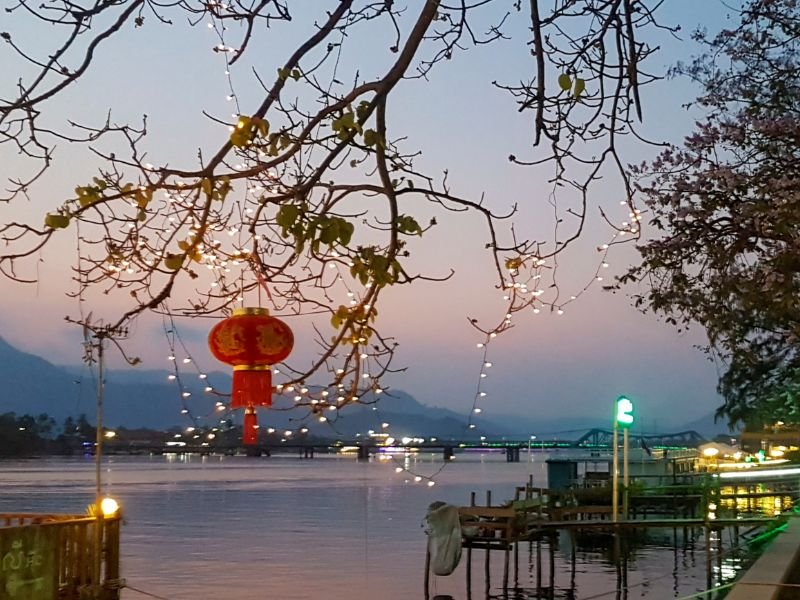
Top 10 Things To Do in Kampot, Cambodia For Visitors
What To Eat and Drink in Kampot, Cambodia
Here are some must-try dishes and drinks to savor during your visit.
1. Kampot Pepper Crab
Kampot is synonymous with pepper, and there’s no better way to experience this prized spice than with the iconic Kampot Pepper Crab. Freshly caught crabs are stir-fried with green peppercorns and a light sauce, creating a dish that is both aromatic and bursting with flavor. The sweetness of the crab meat pairs perfectly with the fiery heat of the pepper, making for an unforgettable dining experience. Many restaurants along the riverside and in nearby Kep serve this specialty, often with stunning views of the water. It’s a must-try for any seafood lover visiting Kampot.
- Fresh Ingredients: Enjoy the delicate flavor of freshly caught crab, enhanced by the unique taste of Kampot green pepper.
- Local Specialty: Kampot pepper is known worldwide for its distinctive flavor and quality, making this dish truly special.
- Beautiful Setting: Savor this dish with a view of the river or the sea, adding to the overall experience.
Tip: Head to Kep’s Crab Market for the freshest crabs and an authentic taste of this classic Cambodian dish.
2. Fish Amok: A Traditional Khmer Delight
Fish Amok is one of Cambodia’s most beloved traditional dishes, and Kampot offers some of the best. This fragrant fish curry is steamed in a banana leaf and made with a rich, coconut-based sauce flavored with lemongrass, turmeric, and kaffir lime leaves. The fish, usually freshwater catfish, is tender and infused with the creamy, aromatic sauce. It’s a beautifully balanced dish, with a subtle sweetness and a hint of spice, often served with rice. Fish Amok is a must-try for those looking to experience the authentic flavors of Khmer cuisine.
- Rich Flavors: The coconut-based sauce is both creamy and fragrant, making each bite a burst of flavor.
- Traditional Presentation: Served in a banana leaf, this dish is as beautiful as it is delicious.
- Perfect Pairing: Usually served with steamed rice, which perfectly complements the rich, flavorful sauce.
Tip: Look for restaurants that offer Amok cooked with local river fish for the most authentic experience.
3. Kampot Pepper Steak
For those who prefer a meaty dish, Kampot Pepper Steak is a fantastic choice. This dish features a juicy steak, typically grilled to perfection, topped with a rich and spicy Kampot pepper sauce. The combination of tender meat and the heat of the pepper creates a savory, satisfying meal that showcases the versatility of Kampot’s famous spice. It’s a popular dish in many of Kampot’s restaurants and is often served with a side of potatoes or steamed vegetables. If you’re a fan of steak, this dish is a must-try.
- Bold Flavors: The spicy Kampot pepper sauce adds a unique kick to the perfectly grilled steak.
- Local Twist: Kampot pepper elevates the traditional steak dish to a new level of flavor and heat.
- Perfect Pairings: Often served with roasted potatoes or sautéed vegetables, making for a hearty and satisfying meal.
Tip: Ask for a side of extra pepper sauce if you love a bit of heat—it’s what makes this dish truly special.
4. Nom Banh Chok: Cambodian Noodle Soup
For a lighter, more refreshing meal, try Nom Banh Chok, a popular Cambodian noodle soup. Often enjoyed for breakfast, this dish consists of rice noodles topped with a light, fragrant fish curry sauce made from lemongrass, turmeric, and kaffir lime. It’s usually garnished with fresh herbs, cucumber, banana blossom, and green beans, adding a crisp, fresh texture to the dish. Nom Banh Chok is a staple in Kampot’s street food scene, offering a delicious and healthy way to start your day.
- Light and Fresh: The delicate fish curry sauce is aromatic and full of flavor, without being too heavy.
- Fresh Herbs and Vegetables: The addition of fresh herbs and vegetables adds a refreshing crunch to the dish.
- Street Food Favorite: A common sight at morning markets and street stalls, this dish is a local favorite.
Tip: Try it from a street food vendor for the most authentic experience—early mornings are the best time to find it.
5. Kep Crab with Kampot Green Pepper Sauce
If you’re a seafood lover, the combination of Kep Crab with Kampot Green Pepper Sauce is a must-try. Freshly caught crab is cooked in a tantalizing sauce made from green Kampot peppercorns, garlic, and a splash of lime. The result is a dish that is both sweet and savory, with the green pepper adding a fresh, zesty kick. This dish is a great way to experience the best of Kampot’s produce in one plate and is typically served with steamed rice or crusty bread to soak up the delicious sauce.
- Fresh and Local: Enjoy the taste of freshly caught crab paired with the distinctive flavor of Kampot pepper.
- Balanced Flavors: The green peppercorns add a refreshing, slightly spicy flavor that complements the sweetness of the crab.
- Perfect Pairings: Usually served with steamed rice or baguette, perfect for soaking up every last bit of the flavorful sauce.
Tip: Enjoy this dish at a riverside restaurant for a truly memorable dining experience with a view.
6. Kampot Iced Coffee
No visit to Kampot is complete without trying the local Kampot Iced Coffee. Made with strong, locally grown coffee, this drink is served over ice and often sweetened with condensed milk. The result is a creamy, refreshing beverage that’s perfect for cooling down on a hot day. Many cafés and street vendors offer variations, including iced coconut coffee and even coffee with a hint of Kampot pepper. It’s a delicious way to sample the local coffee culture and enjoy a unique twist on a classic drink.
- Strong and Flavorful: Kampot’s local coffee is known for its robust flavor, making for a delicious iced coffee.
- Sweetened with Condensed Milk: The addition of condensed milk adds a creamy sweetness that balances the strong coffee.
- Refreshing Beverage: Perfect for a hot day, Kampot iced coffee is both energizing and cooling.
Tip: Try it from a street vendor for the most authentic experience—look for stalls near the river or markets.
7. Durian: The King of Fruits
Kampot is famous for its durian, a tropical fruit known for its distinctive smell and creamy texture. Loved and loathed in equal measure, durian is a must-try for adventurous eaters. The fruit’s custard-like flesh is sweet, with a complex flavor that’s hard to describe—some say it tastes like a mix of almonds, caramel, and garlic. You can find durian at local markets and street stalls, often cut open and ready to eat. Whether you love it or hate it, trying durian is an unforgettable experience and a quintessential part of visiting Kampot.
- Unique Flavor: Durian’s taste is complex and unique, with a creamy texture and a mix of sweet and savory flavors.
- Local Specialty: Kampot durian is considered some of the best in Cambodia, known for its rich flavor and aroma.
- Available at Markets: Find fresh durian at local markets, especially during the peak season from May to August.
Tip: Eat durian outdoors—the strong smell can linger, and it’s not allowed in many hotels and public places.
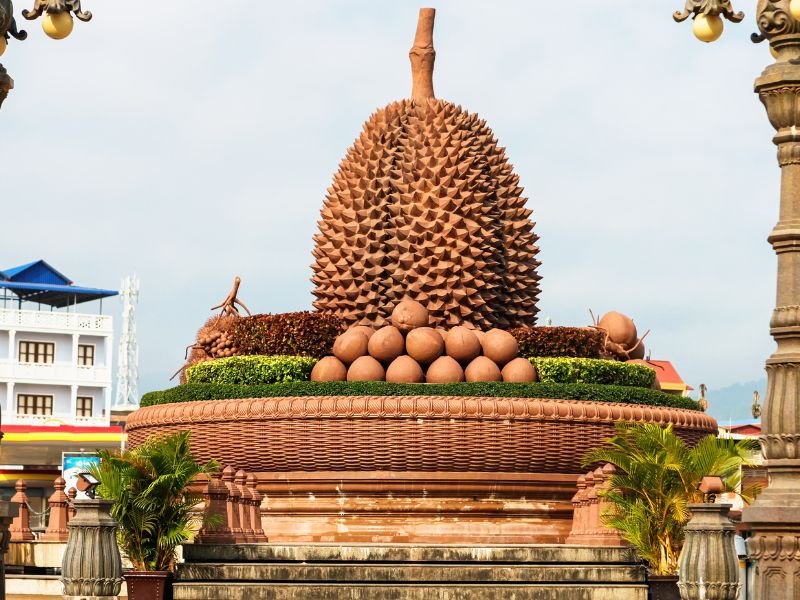
Tours For Visitors To Kampot, Cambodia
Here’s a roundup of some of the best tours to take during your visit to this charming Cambodian town.
1. Kampot Pepper Farm Tour
Kampot is world-renowned for its high-quality pepper, and a pepper farm tour is an absolute must for any visitor. These tours take you through the lush fields where pepper vines climb wooden poles, and you’ll learn about the traditional methods used to cultivate this prized spice. You’ll get to see the entire process, from planting and harvesting to drying and sorting, and discover the differences between black, white, and red peppercorns. The highlight, of course, is the tasting session, where you can sample the various types of pepper and even buy some to take home. It’s an informative and flavorful experience that will deepen your appreciation for this local delicacy.
- Guided Tours: Learn about the history and cultivation of Kampot pepper, one of Cambodia’s most famous exports.
- Pepper Tasting: Try different varieties of pepper, each with its own unique flavor and spice level.
- Farm-to-Table Experience: Purchase freshly harvested pepper directly from the source as a delicious souvenir.
Tip: Combine your pepper farm visit with a trip to the nearby salt fields for a full day of agricultural exploration.
2. Bokor National Park Adventure Tour
For nature lovers and adventure seekers, a Bokor National Park Adventure Tour is a fantastic way to explore this stunning area. The park is home to lush rainforests, diverse wildlife, and the eerie remnants of a former French colonial hill station. Your guide will take you through the park’s highlights, including the abandoned Bokor Palace Hotel, the misty hilltop church, and the stunning Popokvil Waterfall. The tour also offers breathtaking views over the Gulf of Thailand and the surrounding countryside. It’s a great way to experience Kampot’s natural beauty and its fascinating, if somewhat haunting, history.
- Historic Ruins: Explore the abandoned buildings of Bokor Hill Station, including the old hotel and church.
- Wildlife Spotting: Keep an eye out for gibbons, hornbills, and other native species as you trek through the park.
- Scenic Views: Enjoy panoramic views from the summit, with vistas stretching across the coastline and beyond.
Tip: Wear comfortable shoes and bring a jacket—the weather can be unpredictable, and the trails can be slippery, especially after rain.
3. Sunset Cruise on the Kampot River
A sunset cruise on the Kampot River is a relaxing and scenic way to end your day. As the sun dips below the horizon, the sky lights up in vibrant shades of orange and pink, reflecting off the calm waters of the river. You’ll pass by fishing villages, lush mangroves, and perhaps even spot some wildlife, such as kingfishers and fireflies. Many boats offer refreshments and snacks, allowing you to sit back, relax, and take in the stunning scenery. It’s a peaceful experience that showcases the natural beauty of Kampot in a truly magical light.
- Stunning Sunsets: Witness breathtaking sunsets over the river, with the surrounding mountains as a beautiful backdrop.
- Relaxing Atmosphere: Unwind with a drink on board, enjoying the gentle breeze and peaceful surroundings.
- Wildlife Spotting: Keep an eye out for kingfishers, herons, and fireflies as you cruise along the river.
Tip: Book your cruise in advance, especially during high season, to secure a good spot on the boat.
4. Salt Fields Tour
The salt fields of Kampot are a fascinating sight, showcasing one of the region’s traditional industries. This tour takes you to the expansive salt fields just outside the town, where you can see how sea salt is harvested through a simple yet labor-intensive process. Your guide will explain the stages of production, from channeling seawater into the fields to the harvesting and drying of salt crystals. The shimmering white fields against the blue sky make for a striking visual, especially at sunrise or sunset. It’s an intriguing tour that offers a glimpse into a way of life that has remained largely unchanged for generations.
- Traditional Methods: Learn about the traditional techniques used to produce sea salt, an important local industry.
- Beautiful Scenery: The salt fields are particularly picturesque at sunrise or sunset, with the light reflecting off the white salt.
- Meet the Workers: Interact with local workers and learn about their daily routines and the challenges of salt production.
Tip: Visit during the dry season (November to April) when salt production is in full swing and the fields are at their most active.
5. Cycling Tour to Secret Lake and Phnom Chhngok
For those who prefer a bit of adventure, a cycling tour to Secret Lake and Phnom Chhngok Cave Temple is a great way to explore Kampot’s countryside. You’ll ride through picturesque villages, past rice fields and palm trees, experiencing the beauty of rural Cambodia up close. The tour includes a stop at the Secret Lake, a tranquil spot perfect for a refreshing swim or a picnic lunch. You’ll also visit Phnom Chhngok, a limestone cave with a hidden temple inside, offering a fascinating glimpse into the region’s ancient history. It’s a fun and active way to discover the natural and cultural highlights of Kampot.
- Scenic Ride: Cycle through beautiful rural landscapes, passing traditional stilted houses and lush green fields.
- Secret Lake: Enjoy a swim or a picnic by this peaceful lake, surrounded by mountains and palm trees.
- Phnom Chhngok Cave: Explore the ancient temple hidden inside the cave, a unique and atmospheric experience.
Tip: Bring plenty of water and sunscreen—the Cambodian sun can be intense, especially during the midday hours.
6. Cooking Class: Discover Khmer Cuisine
If you’re a foodie, joining a Khmer cooking class is a fantastic way to dive into Cambodia’s culinary traditions. These classes often start with a visit to the local market, where you’ll learn about the key ingredients used in Khmer cooking. Back in the kitchen, you’ll prepare a variety of traditional dishes, such as Fish Amok, fresh spring rolls, and a spicy green mango salad. The hands-on experience, guided by a professional chef, not only teaches you new skills but also provides a deeper appreciation of the flavors and techniques unique to Cambodian food.
- Market Tour: Discover fresh, local ingredients and learn about their importance in Khmer cuisine.
- Hands-On Cooking: Prepare authentic dishes under the guidance of a local chef.
- Culinary Knowledge: Gain insights into the history and cultural significance of each dish you create.
Tip: Come hungry! You’ll get to enjoy a delicious meal of everything you’ve cooked at the end of the class.
7. Explore Kep and Rabbit Island
Just a short drive from Kampot, Kep and Rabbit Island offer a perfect day trip for those looking to enjoy some sun, sand, and fresh seafood. Start your day with a visit to the Kep Crab Market, where you can watch fishermen bringing in their catch and sample delicious crab dishes cooked fresh on the spot. Then, take a short boat ride to Rabbit Island, a tranquil paradise with golden beaches and crystal-clear waters. Spend the afternoon swimming, sunbathing, and exploring the island’s rustic charm before heading back to Kep for a sunset seafood dinner. It’s a relaxing escape that showcases the beauty of Cambodia’s coast.
- Kep Crab Market: Indulge in the famous Kep crab, freshly caught and served with Kampot pepper sauce.
- Rabbit Island: Take a boat ride to this peaceful island, perfect for swimming, sunbathing, and a relaxing escape.
- Beachside Dining: Enjoy a meal at one of Kep’s beachfront restaurants, where the seafood is as fresh as it gets.
Tip: Bring cash and some extra snacks—Rabbit Island has limited amenities, and you’ll want to be prepared for a full day of beach bliss.
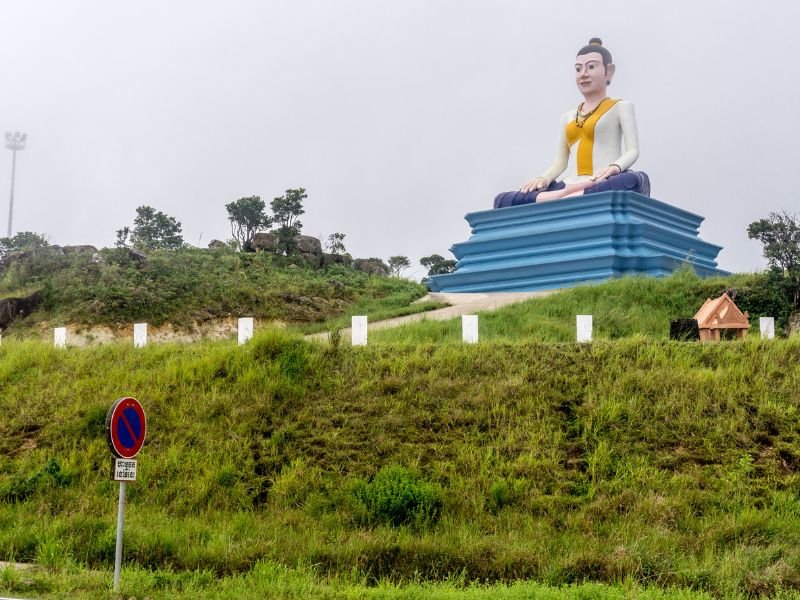
Kampot Accommodations Guide: Hotels, Guesthouses and Hostels
Here’s a guide to some of the best places to stay during your visit.
1. Luxury Hotels: Riverside Elegance and Comfort
For those seeking a touch of luxury, Kampot has a selection of elegant hotels offering stunning river views, top-notch amenities, and a serene atmosphere. These properties often feature spacious rooms with private balconies, infinity pools, and gourmet restaurants serving a mix of local and international cuisine. Many are located just outside the town center, providing a peaceful retreat while still being within easy reach of Kampot’s main attractions. Whether you’re lounging by the pool or enjoying a spa treatment, these hotels provide the perfect setting for a relaxing getaway.
- Riverside Views: Enjoy breathtaking views of the river and mountains from your private balcony or the hotel’s garden.
- Top-Notch Amenities: Indulge in luxury amenities such as infinity pools, spa services, and fine dining options.
- Peaceful Atmosphere: Experience the tranquility of Kampot’s countryside, away from the hustle and bustle of the town center.
Tip: Book a room with a river view—watching the sunset over the water is a truly unforgettable experience.
2. Charming Guesthouses: Local Hospitality and Character
Guesthouses are a popular choice for travelers looking for a more intimate and authentic experience. Kampot’s guesthouses often feature traditional Khmer architecture and personalized service, making them a cozy and welcoming option. Many are family-run and offer home-cooked meals, local insights, and a friendly atmosphere. Whether you’re staying in a rustic bungalow by the river or a charming room in a restored colonial building, these guesthouses provide a comfortable base for exploring the town and its surroundings.
- Authentic Experience: Stay in traditional Khmer-style accommodations that reflect the local culture and architecture.
- Personalized Service: Enjoy warm hospitality and local tips from your hosts, making your stay even more memorable.
- Cozy Atmosphere: Relax in a laid-back setting, often featuring lush gardens, communal spaces, and riverside views.
Tip: Look for guesthouses with free bicycle rentals—it’s a great way to explore Kampot at your own pace.
3. Budget-Friendly Hostels: Social Vibes and Great Value
For backpackers and budget travelers, Kampot’s hostels offer affordable accommodation with a lively social scene. Many hostels feature dormitory-style rooms, communal kitchens, and common areas where you can meet fellow travelers. Some even have swimming pools, on-site bars, and organized activities such as movie nights and barbecues. Hostels are a great way to experience Kampot on a budget, while still enjoying comfortable amenities and a friendly atmosphere. Whether you’re traveling solo or with friends, these budget-friendly options are perfect for making new connections and enjoying all that Kampot has to offer.
- Social Atmosphere: Meet other travelers in shared dorms and common areas, perfect for making new friends and travel buddies.
- Affordable Rates: Enjoy budget-friendly accommodation without sacrificing comfort or convenience.
- Activities and Events: Take part in hostel-organized events like trivia nights, cooking classes, and group tours.
Tip: Check for hostels that offer free breakfast—it’s a great way to start your day and save on food costs.
4. Eco-Resorts: Nature and Sustainability
For travelers seeking a more eco-friendly experience, Kampot offers a selection of eco-resorts that combine comfort with sustainability. These resorts are often located in stunning natural settings, such as riversides or amidst lush gardens, and focus on minimizing their environmental impact. You can expect features like solar-powered energy, organic gardens, and natural building materials. Staying at an eco-resort allows you to enjoy the beauty of Kampot’s surroundings while supporting sustainable tourism practices. It’s an ideal choice for those who value nature and tranquility.
- Sustainable Practices: Enjoy accommodations that prioritize eco-friendly practices such as solar power and water conservation.
- Natural Settings: Stay in beautiful locations surrounded by nature, from riverside bungalows to garden villas.
- Relaxation and Wellness: Many eco-resorts offer yoga classes, meditation sessions, and organic dining options.
Tip: Bring eco-friendly toiletries to support the resort’s sustainability efforts and minimize your environmental impact.
5. Boutique Hotels: Unique Style and Charm
If you’re looking for something with a bit more personality, Kampot’s boutique hotels offer unique accommodations with a blend of traditional and modern design. These hotels often feature individually decorated rooms, creative common spaces, and personalized service. Many are housed in beautifully restored colonial buildings or modern structures with a quirky, artistic flair. Whether you’re sipping cocktails by the pool or relaxing in a stylish room filled with local art, these boutique hotels provide a memorable and Instagram-worthy stay.
- Stylish Interiors: Enjoy rooms with unique décor, blending traditional Khmer elements with modern comforts.
- Creative Spaces: Relax in beautifully designed common areas, often featuring art installations, cozy lounges, and gardens.
- Personalized Experience: Benefit from attentive service and local tips that make your stay special and tailored to your preferences.
Tip: Book in advance—boutique hotels often have limited rooms and fill up quickly, especially during peak season.
source: Savi You on YouTube
Day Trips From Kampot, Cambodia
Here are some of the best day trips to take during your stay.
1. Kep: Seaside Serenity and Fresh Seafood
Just a short drive from Kampot, the coastal town of Kep is a must-visit for anyone looking to enjoy some sun, sand, and delicious seafood. Known for its famous crab market, Kep offers a relaxing atmosphere with stunning views of the Gulf of Thailand. Spend your day exploring the quiet beaches, wandering through the market, and indulging in freshly caught crab served with Kampot pepper sauce. You can also take a short hike through Kep National Park for breathtaking views of the coastline and nearby islands. It’s the perfect escape from the inland heat, offering a delightful blend of natural beauty and culinary delights.
- Crab Market: Savor the taste of freshly caught crab, often served with a tangy Kampot pepper sauce.
- Kep Beach: Relax on the sandy shores and enjoy the calm, clear waters—ideal for swimming or sunbathing.
- Kep National Park: Hike through the park’s trails, offering panoramic views and opportunities for wildlife spotting.
Tip: Visit the crab market early in the morning to see the fishermen bringing in their catch and to enjoy the freshest seafood.
2. La Plantation: Pepper Farm and Beyond
A visit to La Plantation pepper farm is a must for anyone interested in Kampot’s most famous export. This organic farm offers guided tours that take you through the history and cultivation process of Kampot pepper, explaining why it’s considered some of the best in the world. After the tour, enjoy a tasting session where you can sample different types of pepper and learn about their unique flavor profiles. The farm also offers cooking classes, horseback riding, and even a zipline for those looking for a bit of adventure. It’s an educational and enjoyable day out in the beautiful Cambodian countryside.
- Guided Tours: Learn about the traditional methods used to grow, harvest, and process Kampot pepper.
- Pepper Tasting: Sample black, red, and white peppercorns, each with its own distinct flavor and aroma.
- Additional Activities: Enjoy cooking classes, horseback riding, or a thrilling zipline ride over the farm.
Tip: Combine your visit with a stop at the nearby Secret Lake for a swim or a relaxing picnic by the water.
3. Bokor Mountain: History and Nature Combined
A day trip to Bokor Mountain offers a fascinating blend of history and natural beauty. The winding road up the mountain takes you through dense forests and past mist-covered ruins, including the abandoned Bokor Palace Hotel and an old French church. At the summit, you’ll be rewarded with stunning views over the coastline and lush green valleys below. Don’t miss the Popokvil Waterfall, especially during the rainy season when it’s at its most impressive. It’s a great place for hiking, photography, and soaking in the cool mountain air.
- Historic Ruins: Explore the eerie remnants of Bokor Hill Station, including the Bokor Palace Hotel and Catholic church.
- Popokvil Waterfall: Visit this beautiful two-tiered waterfall, particularly spectacular during the rainy season.
- Scenic Views: Enjoy panoramic vistas over the Gulf of Thailand and the surrounding countryside from various lookout points.
Tip: Pack a light jacket—the temperature at the top of Bokor Mountain can be much cooler than in Kampot, especially in the early morning or late afternoon.
4. Phnom Chhngok Cave Temple: A Hidden Gem
Located about 8 kilometers from Kampot, Phnom Chhngok is a fascinating cave temple that dates back to the 7th century. Inside the cave, you’ll find a well-preserved brick temple dedicated to Shiva, surrounded by impressive stalactites and stalagmites. The serene atmosphere and unique setting make this a must-visit for those interested in history and culture. The surrounding countryside, with its rice fields and traditional villages, adds to the charm of this off-the-beaten-path attraction. It’s a peaceful and intriguing spot to explore, offering a glimpse into Cambodia’s ancient past.
- Ancient Temple: Discover the hidden brick temple inside the cave, one of Cambodia’s oldest and best-preserved.
- Natural Beauty: Marvel at the stunning rock formations and the tranquil, cool interior of the cave.
- Scenic Countryside: Enjoy the beautiful rural setting, with lush green fields and distant mountain views.
Tip: Bring a flashlight and wear sturdy shoes—the cave can be dark and slippery in places.
5. Secret Lake: A Tranquil Retreat
Secret Lake, also known as Brateak Krola Lake, is a man-made reservoir created during the Khmer Rouge era. Today, it’s a serene spot surrounded by rolling hills, rice fields, and palm trees. The lake is perfect for a leisurely swim, a peaceful picnic, or a bit of kayaking. Many locals come here to relax, fish, or simply enjoy the beautiful scenery. There are a few small cafés around the lake where you can grab a drink or a snack and take in the tranquil atmosphere. It’s a lovely place to unwind and escape the hustle and bustle of Kampot town.
- Relaxing Atmosphere: Enjoy a peaceful day by the lake, perfect for swimming, picnicking, or just soaking up the scenery.
- Local Flavors: Try some traditional Cambodian snacks or fresh coconuts from the nearby cafés.
- Water Activities: Rent a kayak or paddleboard for a fun and active way to explore the lake.
Tip: Visit in the late afternoon for the best light and to see the local families enjoying the lake at sunset.
6. Teuk Chhou Rapids: Natural Fun and Relaxation
A popular spot for locals and visitors alike, the Teuk Chhou Rapids offer a refreshing escape from the heat. Located just a short drive from Kampot, these natural rapids are surrounded by lush greenery and provide a cool, shaded area for swimming and picnicking. The water flows over smooth rocks, creating natural pools and gentle cascades that are perfect for a dip. There are also small huts available for rent, where you can relax, have a picnic, or even cook your own meal. It’s a great place for a family outing or a lazy day in nature.
- Refreshing Swim: Cool off in the clear, flowing waters of the rapids—ideal for a relaxing swim or just splashing around.
- Picnic Spots: Rent a hut or find a shady spot along the riverbank to enjoy a meal or a nap.
- Natural Beauty: Surrounded by lush trees and plants, the rapids offer a serene and picturesque setting.
Tip: Bring water shoes to navigate the slippery rocks safely and comfortably.
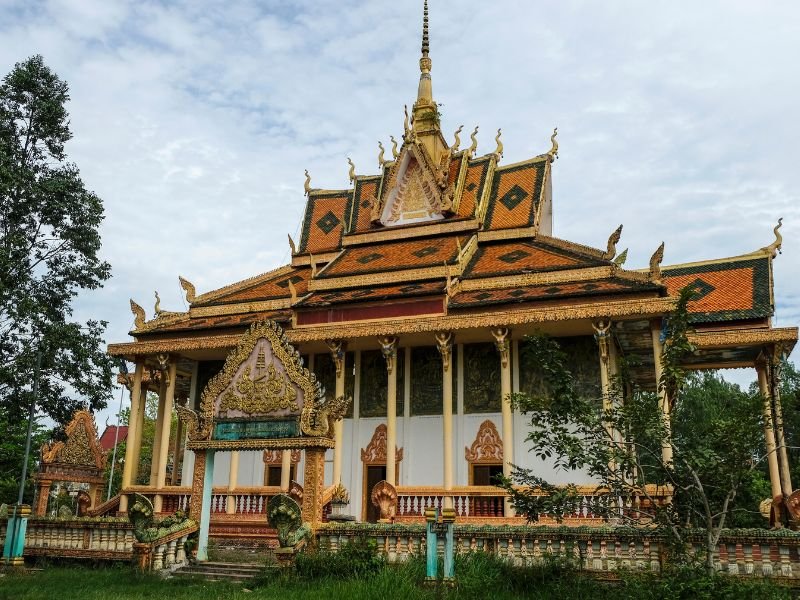
Kampot Transportation Guide
Here’s a detailed guide to help you choose the best way to explore Kampot and its surroundings.
Bicycles: Explore at Your Own Pace
Renting a bicycle is one of the most popular and enjoyable ways to explore Kampot. The town is relatively flat, making it easy to ride around and discover hidden gems at your own pace. You can cycle along the riverfront, through quiet neighborhoods, and out into the countryside, all while enjoying the fresh air and scenic views. Many guesthouses and rental shops offer bicycles for a small daily fee, making it an affordable and eco-friendly way to get around. It’s perfect for those who want to experience Kampot’s laid-back vibe and connect with the local community.
- Affordable Rentals: Most guesthouses and rental shops offer bikes for around $2 to $5 per day.
- Scenic Routes: Ride along the riverfront, through the old town, and out to nearby attractions like the salt fields or pepper farms.
- Eco-Friendly: Biking is a sustainable way to explore Kampot, reducing your carbon footprint while keeping you active.
Tip: Bring a hat and plenty of water, especially if you plan to cycle during the heat of the day.
Tuk-Tuks: Convenient and Comfortable
Tuk-tuks are a convenient and comfortable way to get around Kampot and are readily available throughout the town. These three-wheeled vehicles are perfect for short trips or when you want to explore without the hassle of navigating yourself. Tuk-tuk drivers are generally friendly and knowledgeable, often doubling as informal tour guides. Whether you’re heading to a restaurant, visiting the night market, or taking a day trip to the surrounding countryside, tuk-tuks offer a flexible and affordable way to travel. Be sure to agree on a price before starting your journey to avoid any surprises.
- Flexible Rides: Ideal for short trips around town or visiting nearby attractions such as Bokor Mountain or Kep.
- Local Knowledge: Drivers can provide recommendations and insights about Kampot’s best spots.
- Affordable: Expect to pay around $1 to $3 for short trips within town, and slightly more for longer journeys.
Tip: Negotiate the fare upfront and always carry small bills for easier payment.
Motorbike Rentals: Freedom to Roam
If you’re looking for more freedom and flexibility, renting a motorbike is a great option. Motorbikes allow you to explore Kampot and its surroundings at your own pace, making it easy to visit attractions like the Phnom Chhngok Cave Temple or Secret Lake. Rental shops are plentiful, with daily rates typically ranging from $5 to $10, depending on the type of bike. Be cautious on the roads, as traffic can be unpredictable, and always wear a helmet. It’s a thrilling way to see more of the region and experience the beauty of rural Cambodia.
- Affordable Rates: Motorbikes can be rented for around $5 to $10 per day, depending on the model and rental duration.
- Easy Access: Great for reaching more remote attractions that are difficult to access by bicycle or tuk-tuk.
- Freedom to Explore: Stop wherever you like, explore hidden spots, and travel at your own pace.
Tip: Check the bike thoroughly before renting, and ensure you have a valid driver’s license and travel insurance that covers motorbike use.
Boats: River Cruises and Island Hopping
For a unique perspective of Kampot, consider taking a boat ride along the Praek Tuek Chhu River. Several operators offer river cruises, including sunset cruises that showcase the town’s stunning natural beauty. You can also hire a private boat for a more personalized experience or take a trip out to the nearby islands. Whether you’re looking to relax and take in the views or explore Kampot’s hidden riverside gems, a boat trip is a fantastic way to see the town from a different angle.
- Sunset Cruises: Enjoy breathtaking sunsets over the river, complete with drinks and snacks on board.
- Private Charters: Hire a boat for a day of fishing, island hopping, or exploring the river’s lesser-known areas.
- Scenic Views: See Kampot from a new perspective, with views of the town, surrounding mountains, and lush mangroves.
Tip: Book in advance during peak season, as sunset cruises are popular and can fill up quickly.
Buses and Minivans: Traveling to Nearby Destinations
For those looking to travel beyond Kampot, buses and minivans offer a convenient and cost-effective way to reach nearby destinations like Phnom Penh, Sihanoukville, and Kep. Several companies operate daily services with varying levels of comfort and pricing. Minivans are typically faster but can be cramped, while buses offer more space but take longer. It’s advisable to book your ticket in advance, especially during peak travel seasons, to ensure you get a seat.
- Multiple Routes: Regular services to Phnom Penh, Sihanoukville, Kep, and even further afield to Siem Reap and the Vietnamese border.
- Affordable Options: Tickets typically range from $5 to $15, depending on the distance and level of comfort.
- Reliable Transport: Most companies offer reliable service, with morning and afternoon departures available.
Tip: Arrive at the bus station at least 15 minutes before departure to ensure a smooth and stress-free journey.
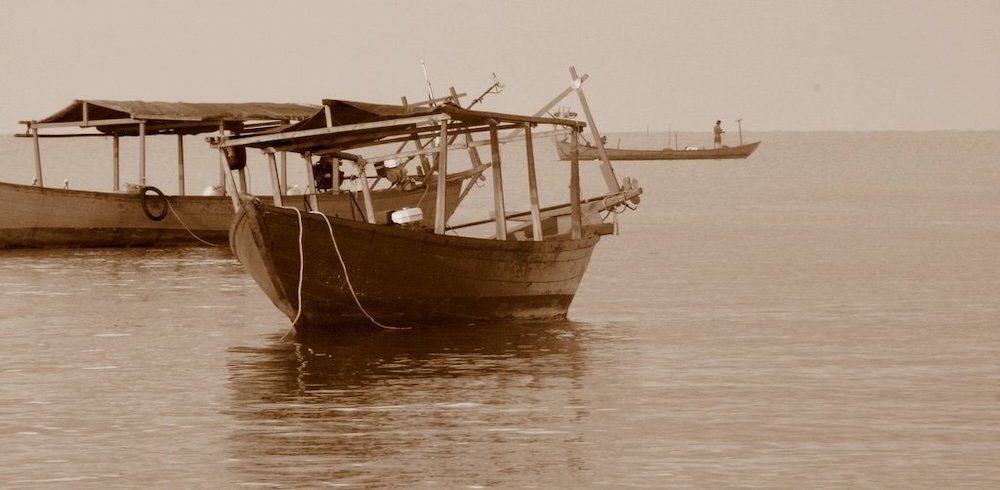
Where To Visit After Your Trip To Kampot?
Here are some top destinations to consider visiting after your time in Kampot.
1. Sihanoukville: Gateway to Cambodia’s Islands
Sihanoukville is the perfect destination if you’re craving sun, sand, and sea. This coastal city is known for its vibrant nightlife, beautiful beaches, and as the jumping-off point for Cambodia’s stunning islands. Spend a few days lounging on Otres Beach or head out on a boat trip to explore the nearby islands like Koh Rong and Koh Rong Samloem. Despite its rapid development, Sihanoukville still offers a mix of lively spots and quieter areas where you can unwind. It’s a great place to recharge before heading to the islands or continuing your journey through Cambodia.
- Island Hopping: Take a boat tour to explore the beautiful islands of Koh Rong and Koh Rong Samloem.
- Beach Vibes: Relax on Otres Beach or Serendipity Beach, known for their laid-back atmospheres and stunning sunsets.
- Nightlife: Experience the lively nightlife with beach bars, clubs, and casinos offering entertainment late into the night.
Tip: Visit during the dry season (November to April) for the best beach weather and calm seas.
2. Phnom Penh: Cambodia’s Capital City
If you’re interested in diving into Cambodia’s history and culture, Phnom Penh is a must-visit after Kampot. The capital city is bustling with energy and offers a mix of traditional and modern attractions. Explore the Royal Palace and the Silver Pagoda, visit the sobering Tuol Sleng Genocide Museum, or take a sunset cruise along the Mekong River. Phnom Penh’s vibrant street food scene and bustling markets also provide plenty of opportunities to sample local flavors. It’s a dynamic city that gives you a deeper understanding of Cambodia’s past and present.
- Historic Sites: Visit the Royal Palace, Silver Pagoda, and the National Museum to learn about Cambodia’s rich cultural heritage.
- Somber History: Pay your respects at the Tuol Sleng Genocide Museum and the Killing Fields of Choeung Ek.
- Mekong River: Enjoy a sunset cruise on the Mekong River, offering beautiful views of the city skyline.
Tip: Consider taking a guided tour to better understand the historical context and significance of these sites.
3. Koh Kong: Eco-Adventures and Wildlife Encounters
For those looking to immerse themselves in nature, Koh Kong is an ideal destination. Located near the border with Thailand, this province is home to lush rainforests, beautiful waterfalls, and the pristine Cardamom Mountains. Go on a jungle trek, visit the Tatai Waterfall, or take a boat tour through the mangroves of Peam Krasaop Wildlife Sanctuary. Koh Kong is also a great base for exploring the nearby Cardamom Tented Camp, where you can stay in eco-friendly accommodations and experience Cambodia’s wildlife up close. It’s a paradise for adventure seekers and nature lovers.
- Eco-Tours: Explore the dense rainforests and mangroves with guided eco-tours that focus on conservation and sustainability.
- Waterfalls and Rivers: Visit the stunning Tatai Waterfall or take a boat trip along the peaceful Tatai River.
- Wildlife Sanctuaries: Discover the unique flora and fauna of Peam Krasaop Wildlife Sanctuary and the Cardamom Mountains.
Tip: Pack insect repellent and light, breathable clothing—Koh Kong’s rainforests are beautiful but can be humid and buggy.
4. Takeo: Ancient Temples and Countryside Charm
Takeo is a lesser-known destination that offers a tranquil escape and a glimpse into Cambodia’s ancient history. Often referred to as the “Cradle of Khmer Civilization,” Takeo is home to several pre-Angkorian temples, including the famous Phnom Da and Angkor Borei. Explore these historical sites, take a boat ride along the canals, or simply enjoy the peaceful countryside atmosphere. It’s a great place to experience rural Cambodia and learn more about the country’s ancient roots without the crowds of more popular destinations.
- Ancient Temples: Visit Phnom Da and Angkor Borei to see some of Cambodia’s oldest archaeological sites.
- Canal Boat Rides: Enjoy a peaceful boat ride through the canals, offering beautiful views of the countryside.
- Local Life: Experience the charm of rural Cambodia, with its traditional stilted houses and friendly locals.
Tip: Hire a local guide to explore the temples and learn about their historical significance and myths.
5. Battambang: Art, Culture, and Countryside Adventures
Battambang is often overlooked by travelers, but this charming town is worth a visit for its artistic atmosphere and scenic surroundings. Known for its well-preserved French colonial architecture, vibrant arts scene, and the famous bamboo train, Battambang offers a more laid-back experience compared to Siem Reap or Phnom Penh. Explore the town’s galleries, take a ride on the bamboo train, or visit the nearby Phnom Sampeau for stunning views and the eerie Killing Caves. Battambang’s lush countryside is also perfect for cycling tours, where you can discover traditional villages, local farms, and ancient temples.
- Bamboo Train: Take a unique ride on the bamboo train, a fun and quirky way to explore the countryside.
- Art and Culture: Visit local galleries and workshops to see contemporary Cambodian art and traditional crafts.
- Phnom Sampeau: Hike up this hill for panoramic views and explore the somber Killing Caves, a reminder of Cambodia’s dark past.
Tip: Join a guided cycling tour to explore the rural areas around Battambang and learn about local life and traditions.
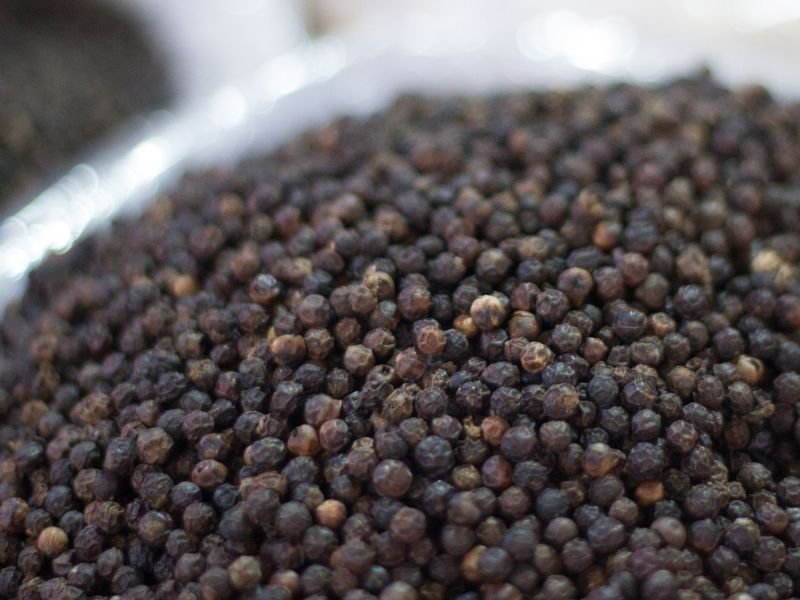
Kampot Travel Guide: Final Thoughts
Here are some final thoughts to take with you as you reflect on your time in Kampot.
Embrace the Slow Pace of Life
One of the most beautiful aspects of Kampot is its relaxed pace of life. Here, there’s no need to rush from one attraction to the next. Take your time to stroll along the riverfront, enjoy a leisurely meal at a café, or chat with locals about their lives and experiences. This town is about more than ticking off a checklist of sights—it’s about soaking in the atmosphere and appreciating the simple pleasures. So, let yourself unwind and go with the flow.
- Relax by the River: Spend an afternoon watching boats drift by and locals fishing from the shore.
- Enjoy Local Cuisine: Take the time to savor traditional Khmer dishes and freshly caught seafood.
- Connect with the Community: Engage with locals and fellow travelers—Kampot is a place that encourages connection.
Tip: Don’t plan too much—leave space in your itinerary for spontaneous moments and unplanned discoveries.
Discover Kampot’s Unique Heritage
Kampot’s history is a fascinating blend of French colonial influences, traditional Khmer culture, and the legacy of its agricultural wealth. From the charming old town architecture to the stories behind its famous pepper, there’s a rich heritage to explore here. Take the time to visit the local museums, learn about the region’s history, and appreciate the unique blend of cultures that have shaped this town. It’s a reminder of how much there is to discover beyond the surface.
- Colonial Architecture: Wander through the old town and admire the beautifully preserved French colonial buildings.
- Pepper History: Learn about Kampot’s pepper industry and its role in the local economy and culture.
- Local Museums: Visit the Kampot Provincial Museum for a deeper understanding of the town’s history and heritage.
Tip: Join a guided walking tour to get a local’s perspective on Kampot’s rich history and cultural significance.
Savor the Natural Beauty
Kampot is blessed with stunning natural beauty, from its lush countryside and serene river to the dramatic landscapes of Bokor Mountain. Whether you’re exploring hidden caves, kayaking on the river, or hiking through the national park, there’s no shortage of opportunities to connect with nature. Take a deep breath, look around, and let the scenery sink in. It’s these moments of tranquility and awe that make Kampot such a special place.
- Outdoor Adventures: Go kayaking on the river, explore the salt fields, or hike up Bokor Mountain for incredible views.
- Beautiful Landscapes: Enjoy the lush greenery, rolling hills, and tranquil waters that surround Kampot.
- Wildlife Spotting: Keep an eye out for local wildlife, from colorful birds to playful monkeys in the forests.
Tip: Bring a good camera and binoculars—there’s plenty of natural beauty and wildlife to capture and admire.
Experience the Flavors of Kampot
From its famous pepper to its fresh seafood, Kampot is a paradise for food lovers. Whether you’re dining at a riverside restaurant, exploring the night market, or taking a cooking class, there are endless opportunities to indulge in delicious local flavors. Don’t be afraid to try something new—whether it’s a peppery crab dish or a bowl of fish amok, Kampot’s cuisine is a reflection of its rich cultural heritage and bountiful natural resources.
- Pepper Crab: Try the iconic Kampot pepper crab, a must-try dish for any seafood lover.
- Street Food: Explore the night market for a taste of local snacks and traditional Khmer dishes.
- Cooking Classes: Join a cooking class to learn how to make classic Cambodian dishes using fresh, local ingredients.
Tip: Ask for recommendations from locals—they know the best spots for authentic and delicious food.
Plan Your Next Adventure
Kampot may be a place to relax, but it’s also a great jumping-off point for exploring more of southern Cambodia. From the beaches of Kep to the vibrant capital city of Phnom Penh, there are plenty of destinations nearby that offer new experiences and adventures. So, while you’re enjoying your time in Kampot, start thinking about where you’d like to go next. The journey doesn’t end here—there’s so much more to see and do.
- Explore Kep: Visit the nearby coastal town of Kep for its famous crab market and beautiful beaches.
- Discover Phnom Penh: Head to the capital city to experience Cambodia’s bustling urban life and rich history.
- Island Getaways: Consider a trip to the nearby islands like Koh Rong or Koh Rong Samloem for pristine beaches and crystal-clear waters.
Tip: Plan your transportation in advance, especially during peak travel seasons, to ensure a smooth and stress-free journey.

